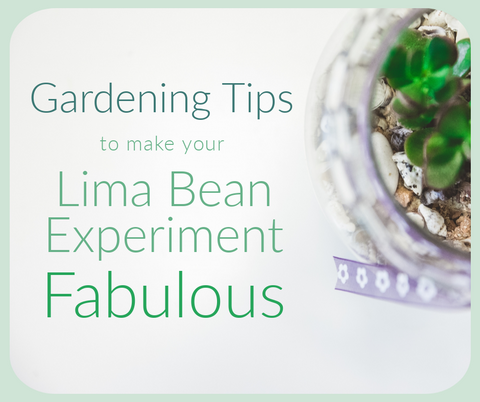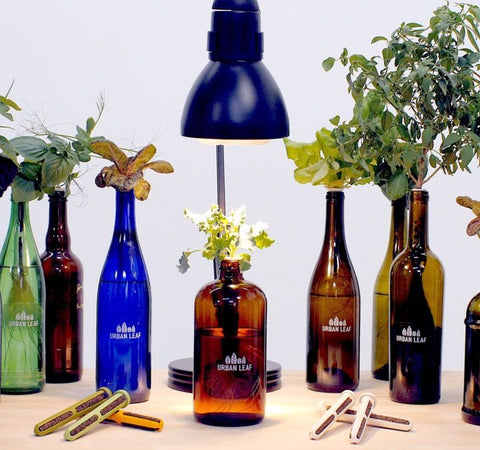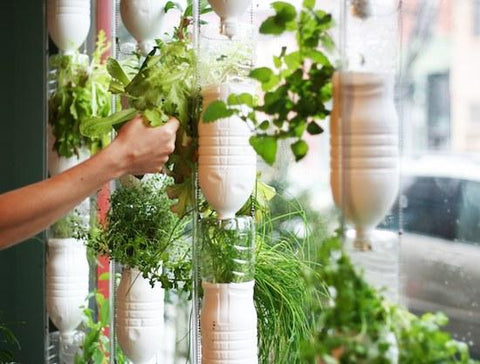Some time during the year, school-aged kids may have to try growing a bean in a jar. This classic experiment is great fun for the kids and there are plenty of opportunities to teach your students about plants and to introduce the scientific method.
In the experiment, keep a control group of beans while changing conditions for other groups, and have students keep science journals to track the beans’ progress. To add some more fun, read growing-related stories like Jack and the Beanstalk!
Lima beans are usually robust sprouts, but if you want to make your experiment extra fabulous, try these tips.

Tip #1. Use glass bottles and cotton balls to help your students with observation and prevent bean rot
Most versions of this experiment instruct students to dampen two paper towels, insert the lima bean between them, and slide everything into a plastic bag. While this keeps the bean moist, it limits what students can see. There’s also the potential to overwater the paper towels, which will cause the beans to rot rather than grow.
As a less risky and more aesthetic alternative, use cotton balls and a mason jar. Dampen the cotton balls and place them at the bottom of the jar, and slide the bean against one side of the jar just under the top layer of cotton balls. Your students will be able to see the bean’s roots and leaves as it grows, and the cotton balls will keep the bean moist.
As an added bonus, it’s easier to re-dampen cotton balls in a widemouth glass jar than it is in a plastic baggie. Get a mister and let students spray the cotton balls to wet them.
Tip #2. If you only have plastic baggies, staple the bottom fourth of the bag for better drainage
Sprouts don’t like sitting in water. In the classic bean experiment, beans tend to sink to the bottom of a plastic bag, where they can end up too moist. It’s easy to overwater a bean and have it grow mold or rot instead of sprouting!
If you’re using baggies, use a stapler to line up several staples horizontally along the bottom fourth of the bag. Let the bean sit on top of the staples. If your students accidentally overwater their beans, the extra water will collect at the bottom of the bag, but the bean will stay properly moist.
Tip #3. Use colored cellophane or film to alter the light in the bottle
Part of the fun of the experiment is to see what happens when you alter the bean’s growing environment. The most common conditions to alter are light and liquid type (like what happens if you add juice? milk? soda?), but if you’re feeling adventurous, try changing the color of the light in the jar to see what happens to the bean. Plants rely on red and blue frequencies to photosynthesize, so using film of this color will allow red and blue rays to get through, and your plant will grow happily. However, using a green or brown film will block photosynthesis and prevent your plant from growing well. Read our article about how colored bottles affect growth here.
Try putting one plant in the dark, wrapping a few jars in green or brown film, and wrapping a few jars in red or blue film. All of the beans may sprout, but after a week the ones in the clear, red, or blue jars should be stronger than the ones in the green and brown jars, and all should be stronger than the plant grown in the dark. Talk to your students about how plants need light of a specific type to grow and use prisms or rainbows for demonstratives
Tip #4. Set up your bottles on a windowsill to make a window garden
Many teachers tape plastic bags to the window. That works, but it can look messy. If you’re using jars and you have a windowsill, set all your jars along the sill instead.
For a fun class project, you can have students decorate their jars before you fill them. Provide markers or stickers so each student can personalize their jar. Just make sure that any added decoration won’t prevent light from entering the jar. For more tips, read our article on how to select the perfect spot for a plant to grow.
Tip #5. Have an adult growing experiment
At Urban Leaf, we think everyone should have fun with plants! (In fact, we love to experiment with our own plants! Check out how we tested the best growing environment for our herbs.) Our herb bottle gardens require even less maintenance than the classic lima bean experiment and yield even tastier results. (They’re also really pretty!) We’ve incorporated the principles of light and water above into our garden designs, so that growing plants is easy and hassle-free.
All you need isa good window with plenty of light (or our LED Grow Light) and you can keep your own indoor garden at home!










My son is doing an experiment for school to see if the phases of the moon affect plant growth. He planted a lima bean on 02/01/22, in a small glass jar with potting soil and put it in our window seal inside. but 3 days later we had freezing temperatures in the 20’s. We forgot to take the plant out of the window seal, but it was inside the entire time. Will this damage the seedling? It has been 11 days since planting and no growth can be seen.